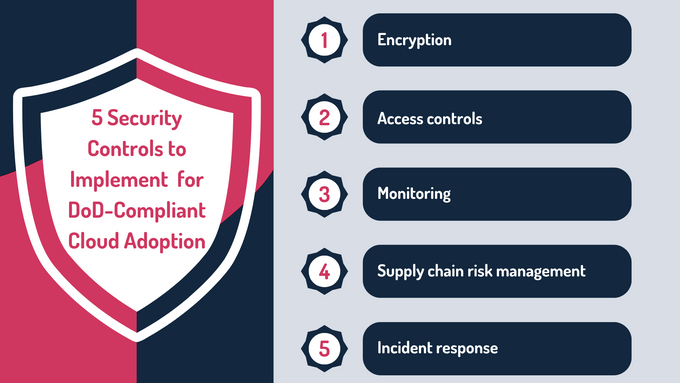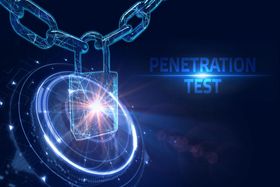DoD Cloud Security Requirements: How to Secure Cloud Adoption
Discover how to navigate DoD SRG and meet cloud computing security requirements to ensure secure cloud adoption for DoD operations.
Published March 30, 2025.

Adopting cloud computing for Department of Defense (DoD) operations requires meeting strict security standards. The DoD Security Requirements Guide (SRG) outlines critical cloud computing security requirements to ensure that sensitive data and systems are protected in the cloud. Organizations must comply with these guidelines to securely leverage cloud services while maintaining operational integrity.
This blog will provide an overview of these requirements and practical steps for aligning with them. Ensuring compliance with these guidelines helps organizations maintain a secure cloud environment and supports the mission-critical operations of the DoD.
» Contact us for expert, all-in-one cyberservices
What Is the DoD Cloud Computing Security Requirements Guide?
The Department of Defense (DoD) Cloud Computing Security Requirements Guide (CC SRG) establishes security standards for cloud service providers (CSPs) that handle DoD data. It ensures CSPs meet strict security controls before receiving a DoD provisional authorization to host DoD workloads.
The CC SRG builds on the Federal Risk and Authorization Management Program (FedRAMP) Moderate baseline, incorporating additional DoD-specific security enhancements (FedRAMP+) to mitigate insider threats and advanced persistent threats.
CSPs must also follow DoD Security Technical Implementation Guides (STIGs) and provide dedicated infrastructure for Impact Levels 4 and above, ensuring that DoD data remains protected in cloud environments.
» Did you know? The cloud might not be safe anymore
3 Key Security Objectives of the DoD SRG
- Confidentiality: Ensuring that sensitive DoD data is protected from unauthorized access.
- Integrity: Maintaining the accuracy and reliability of data to prevent unauthorized modifications.
- Availability: Ensuring mission-critical systems remain accessible when needed.
DoD SRG vs. FedRAMP
| Feature | FedRAMP | DoD SRG |
|---|---|---|
| Applicability | Used by all federal agencies | Exclusive to DoD cloud environments |
| Data Classification | Covers up to moderate/high security levels | Uses Impact Levels (IL2–IL6) to classify public data |
| Security Controls | Follows FedRAMP security baselines | Expands with DoD FedRAMP+ controls to counter more advanced cyber threats |
| Access Controls | Standard identity verification | Requires stricter access controls and personnel vetting (e.g., U.S. citizenship for IL4/IL5) |
| Separation of Data | Logical separation in cloud environments | Physical and logical separation of DoD systems to enhance security |
| Risk Management | Uses a general risk-based approach | Requires compliance with DoD’s Risk Management Framework (RMF) for mission-critical security |
» Understand risk assessments and their importance
Impact Level Framework in the DoD SRG
The impact level (IL) framework in the DoD SRG categorizes cloud environments based on data sensitivity and security needs. It follows CNSSI 1253 and the FedRAMP Moderate Baseline, with all levels requiring at least moderate confidentiality and integrity.
- IL1: IL1 is generally considered for information that is publicly releasable. Because this information has no real security concerns, it is often considered that there is no need for a specific DoD impact level to be applied. So it is often stated that IL1 is not utilized
- IL2: This includes data cleared for public release and some DoD private unclassified information and requires a minimal level of access control.
- IL4: IL3 has been consolidated into IL4 to streamline the DoD's security requirements. It now accommodates Controlled Unclassified Information (CUI), which can be provided on shared or dedicated infrastructure.
- IL5: Provides support for unclassified National Security Systems (NSSs) and can handle CUI that requires more security. It requires specific infrastructure. Only DoD private, DoD community, and Federal Government community clouds are eligible.
- IL6: Handles classified data up to the secret level. Requires a cloud enclave connected to the Secret Internet Protocol Router Network (SIPRNet).
Authorization Process for Commercial CSPs Under the DoD SRG
CSPs must receive a provisional authorization from the Defense Information Systems Agency (DISA) to operate under the DoD SRG. There are three ways a CSP can be evaluated for a DoD PA:
- FedRAMP Joint Authorization Board (JAB) PA: CSPs that have already obtained or are in the process of obtaining a FedRAMP JAB provisional authorization can use this as a foundation for DoD authorization.
- Federal agency authorization: If a CSP has received authorization from a federal agency, with security controls assessed by a certified Third Party Assessment Organization (3PAO), it may apply for a DoD provisional authorization.
- DoD self-assessed PA: In this case, DISA’s cloud assessment team conducts an independent evaluation of the CSP, separate from FedRAMP.
Challenges in Meeting DoD SRG Requirements
Meeting DoD SRG security requirements presents several challenges for CSPs due to the additional controls beyond FedRAMP baselines:
- Stronger security controls: CSPs must implement extra measures, including NIST SP 800-53 controls and additional DoD-specific security requirements not covered by NIST standards.
- Physical separation requirements: Impact Level 5 (IL5) requires dedicated infrastructure that is physically separate from non-DoD tenants, increasing operational complexity and costs.
- Personnel vetting: CSPs handling IL4/IL5 data must follow strict personnel screening procedures, such as requiring U.S. citizenship, adding administrative and compliance burdens.
» Worried about your startup's security? Here are some cyber tips for your startup plan
5 Security Controls to Implement for DoD-Compliant Cloud Adoption
1. Encryption
Organizations should implement FIPS 140-2 validated encryption for both data-at-rest and in-transit. It’s also crucial to destroy encryption keys during data spills and ensure data is restored from clean backups to maintain data integrity and security.
Depending on the circumstances, you may also want to implement symmetric and asymmetric encryption.
» Did you know that attackers use encryption as well? Here's how to deal with ransomware
2. Access Controls
Zero trust architecture (ZTA) plays a critical role in the DoD’s cloud security strategy. This model helps ensure the integrity of the system by assuming that no device, user, or system should be trusted by default.
Key aspects include:
- Enforce strong access control: ZTA principles require rigorous access verification at every point, even for users inside the network. Multi-factor authentication (MFA) is a core component, ensuring that access requests are properly authenticated and secure.
- Continuous monitoring: ZTA mandates continuous monitoring and validation of all access requests, ensuring that no unauthorized access occurs. It supports continuous risk assessment, which aligns with DoD’s need for constant vigilance over cloud resources.
» Here are the things you should know before hiring a risk assessment provider
3. Monitoring
The FedRAMP continuous monitoring strategy and the DoD Risk Management Framework (RMF) serve as the cornerstones of continuous monitoring.
Continuous monitoring involves the ongoing, real-time evaluation of CSPs to ensure compliance with DoD security requirements.
To implement effective real-time security monitoring, organizations should:
- Establish organization-defined metrics: These metrics help track and assess security controls and overall compliance.
- Define monitoring frequencies and assessments: Organizations must establish a clear schedule for monitoring, ensuring consistency.
- Follow the continuous monitoring plan: Regular assessments should align with the organization’s predefined monitoring strategy to maintain security.
- Hire and finance a Mission CND (MCND): This ensures the protection of apps, systems, and virtual networks within the IaaS/PaaS infrastructure of any CSP.
- Use an assured compliance assessment solution (ACAS): Implement scanning and ensure all security standards are continuously verified.
» Protect yourself from internet vulnerabilities by understanding phishing attacks
4. Supply Chain Risk Management
Supply chain risk management (SCRM) is integral to the DoD’s cloud security requirements. To ensure supply chain integrity, organizations must develop a comprehensive SCRM plan that includes an anti-counterfeit strategy.
To align with SRG guidelines and ensure vendor compliance, organizations should:
- Conduct vendor assessments: Evaluate suppliers using frameworks like NIST SP 800-161 to identify risks in hardware, software, and services.
- Implement cybersecurity standards: Require vendors to adhere to CMMC and FIPS-compliant encryption protocols.
- Enforce contractual obligations: Include clauses mandating secure development practices and incident reporting in contracts.
- Leverage continuous monitoring: Use security information and event management (SIEM) tools for real-time threat detection across the supply chain.
- Collaborate on threat intelligence: Engage in programs like the Defense Industrial Base Collaborative Information Sharing Environment (DCISE) to exchange information on emerging threats.
5. Incident Response
Organizations must coordinate incident response and threat intelligence sharing across CSPs, CND entities, and mission owners to defend DoD systems. This shared responsibility ensures quick detection, reporting, and mitigation of security threats.
To comply with FedRAMP and DoD guidelines, organizations need an incident response plan addendum that addresses integration and data breaches. This addendum should meet SRG reporting requirements and be reviewed by DISA.
Incident reporting obligations under the SRG include:
- Incident reporting to MCND: CSPs must report incidents to the MCND, which coordinates with the BCND as necessary.
- Initial incident reports: These must be submitted within one hour of discovery, with follow-up information provided as it becomes available.
- US-CERT reporting lexicon: Reports should align with the reporting standards established by US-CERT.
- Incident response plan or addendum: CSPs must provide a plan or addendum addressing data breaches and ensuring government notification.
- Incident reporting for dedicated DoD infrastructure: Incidents must be reported directly to the DoD.
- Incident reporting in multi-tenant environments: Incidents must be reported to both US-CERT and the DoD.
Take Note: Recent updates to the DoD Cloud Computing SRG include the shift from NIST SP 800-53 Rev 4 to Rev 5 and alignment with CNSSP-32. The SRG now splits into two documents:
- DoD CSP SRG
- DoD Mission Owner SRG
Organizations must ensure they follow new reciprocity between FedRAMP and DoD impact levels and understand increased penetration testing rights in IL6 environments to maintain compliance and support DoD missions.
» Learn more about the different types of penetration testing and the key pentesting steps
Securing Cloud Adoption for DoD Compliance
GRSee Consulting can help your organization navigate the complex requirements of secure cloud adoption in the DoD. Adhering to the stringent guidelines outlined in the CC SRG and DoD SRG is essential. By implementing robust security controls such as encryption, access controls, continuous monitoring, and incident response protocols, organizations can ensure they meet these standards.
This approach not only safeguards sensitive data but also aligns with the overall security strategy for supporting DoD missions and maintaining operational integrity.
» Contact us to ensure your cloud adoption meets the highest security standards





